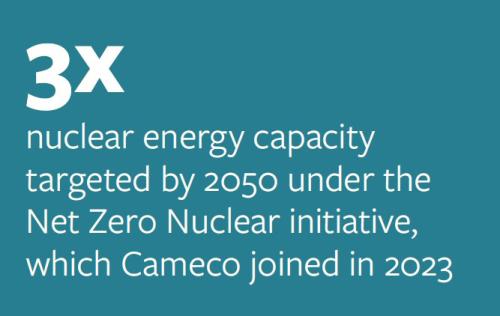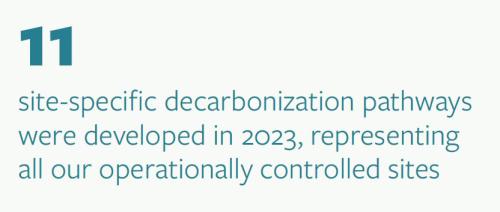Our Approach to Climate Disclosures
We integrate climate-related risks and opportunities into our governance, strategy, risk management, and metric and target-setting processes in alignment with the Task Force on Climate-Related Disclosures (TCFD).
This is the fourth time we have reported in alignment with the TCFD recommendations. Climate-related disclosures have been integrated throughout this report and other disclosure documents, such as our management’s discussion and analysis (MD&A), and annual information form (AIF).

For a summary of material risks to our business operations, revenue, or expenditures, please see our annual MD&A and AIF. The Financial Stability Board has asked that the IFRS Foundation take responsibility for climate-related disclosures, the timing of and extent to which Canada may adopt these standards remains unclear. Therefore, we continue to align our disclosure with the TCFD recommendations.
I. Governance
We believe that sound governance is the foundation for strong corporate performance in all areas of our business.
Within Cameco, our board of directors holds the highest level of oversight for our business strategy and strategic risks and opportunities, including climate-related risks and transition-related opportunities.
II. Risk Management
Our risk program involves a broad, systematic approach to identifying, assessing, reporting and managing the significant risks we face in our business and operations.

Our corporate risk register tracks enterprise-level risks, which are risks that have the potential to significantly affect our ability to achieve our corporate objectives or strategic plan. Once risks are identified and assessed, we consider the risk mitigation plan. Senior management is responsible for verifying that key risks, as well as emerging risks, are identified, are managed to an acceptable level and are reported on regularly to the appropriate level within the organization. The enterprise risk register is reviewed and provided to the executive team and the board each quarter.
Cameco is aware of the increasing risk changing climate conditions can create for our operations and value chain. We have, currently and historically, identified and managed risks posed by acute physical climate events (e.g., wildfire and flooding) and chronic changes in climate patterns (e.g., temperature and precipitation), as well as risks posed by changes in regulations or policy. Some of the elements of our risk management processes that focus on climate-related risks include:
- Climate risk identification
- Risk assessment
- functional risks
- tactical risks
- strategic risks
- Monitoring and reporting
- Risk management
- Climate risk integration
- accountability
- physical risks
- capital allocation
- carbon compliance costs
decarbonization projects into our projects
III. Strategy
Cameco is a pure-play investment in the growing demand for nuclear energy, focused on taking advantage of the near-, medium-, and long-term growth occurring in our industry.
We provide nuclear fuel products, services, and technologies across the fuel cycle, augmented by our investment in Westinghouse, supporting the generation of zero-carbon nuclear energy. Cameco’s business strategy is to capture full-cycle value by:
- remaining disciplined in our contracting activity,
- building a balanced portfolio in accordance with our contracting framework,
- profitably producing from our tier-one assets and aligning our production decisions in all segments of the fuel cycle
with contracted demand and customer needs, - exploring other emerging opportunities within the nuclear power value chain, which align with our commitment to manage our business responsibly and sustainably, contribute to decarbonization, and help to provide secure and affordable energy, and
- being financially disciplined to allow us to execute our strategy, invest in new opportunities that are expected to add long term value, and to self-manage risk.

We expect our strategy will allow us to increase long-term value for our stakeholders, and we plan to execute it with an emphasis on safety, people, and the environment. 2023 was another positive year for the nuclear energy industry. Demand for nuclear power, including support for existing reactors, continues to grow, catalyzed by the increasing recognition by policy makers and major industries that nuclear energy must play an important role in achieving the objectives of providing clean, secure, reliable, and affordable energy.
We recently announced our commitment to the Net Zero Nuclear initiative, which is calling for collaboration among government, industry leaders and civil society to triple global nuclear capacity to help achieve carbon neutrality by 2050.
IV. Metrics and targets
Metrics and targets are important tools to measure and monitor progress. We are focused on better understanding the impact of climate-related risks and opportunities and reducing our GHG emissions.

Climate-related metrics
We have tracked and reported GHG emissions for more than two decades. Our performance on Scope 1 and Scope 2 emissions is included in our 2023 Sustainability Report.
In 2023, we continued to work to better understand our total Scope 3 emissions, our most significant Scope 3 categories and to identify the companies in our value chain that make the largest contribution. We have included our estimated total Scope 3 emissions value and quantification method in this report. Where practical, we also started to engage with key value chain partners and suppliers on understanding their energy and emissions management capabilities and identifying Scope 3 emissions reduction opportunities.
